A new doubly-charmed particle has been discovered at the LHC
Today is a great day for particle physics, as a discovery has been announced by the LHCb collaboration. A new particle has indeed been observed in LHC data.
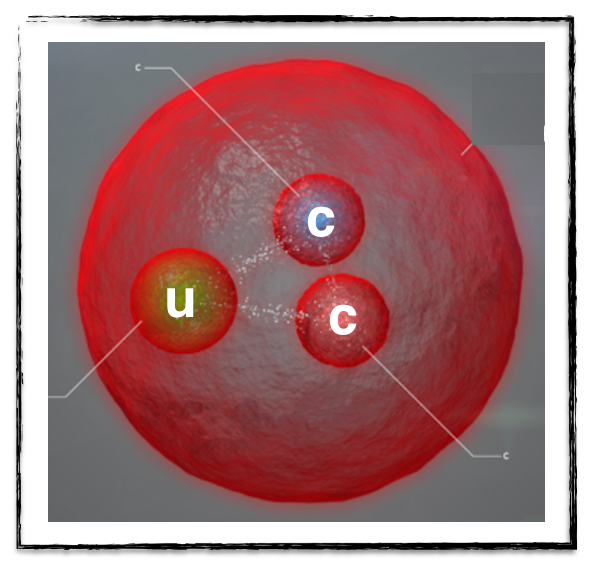
[image credits: CERN]
In a couple of previous posts, I already mentioned how well the LHCb experiment of the LHC is doing. And today, once again, LHCb surpassed all expectations: it observed a new particle made of two charm quarks (c on the picture on the left) and one up quark (u on the picture on the left).
Such a particle is named a Ξcc++, where there is in principle no spacing between the ++ and the Ξ symbol, but markdown is what it is…
It is also more or less convenient to pronounce: ‘ksi - see see - plus plus’.
The double ‘c’ stands for the fact that there are two charm quarks involved, and the double ‘+’ indicates that the electric charge is of 2 units.
Who told anyone that scientists were good in finding names? ;)
THE LHCb EXPERIMENT IN A FEW WORDS
It is good to mention, once again, some words about the apparatus that has made the discovery I want to talk about possible. The image below shows the LHCb detector being assembled in its cavern around the collision point of the two LHC beams.
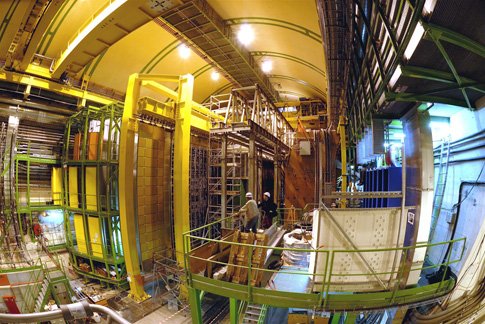
[image credits: LHCb @ CERN]
The LHCb detector has been built to study a very specific type of particles, that have the property that they are generally produced in a configuration where they stay close to the LHC beams.
As a result, the LHCb detector has been adapted and is very good in investigating what is going on along the LHC beam line.
It can be seen as a huge apparatus made of smaller subdetectors, that are aligned along the beam line starting from the collision point. This is very similar as when one aligns books in a bookshelf.
Each book (or subdetector) is dedicated to explain one feature of one or more particle species, and by putting all the information together, physicists are capable to reconstruct what happened in the collisions.
COMPOSITE STATES MADE OF QUARKS
At the beginning of this post, I mentioned that the new particle that has been discovered is made of three quarks: two charm quarks and one op quark.
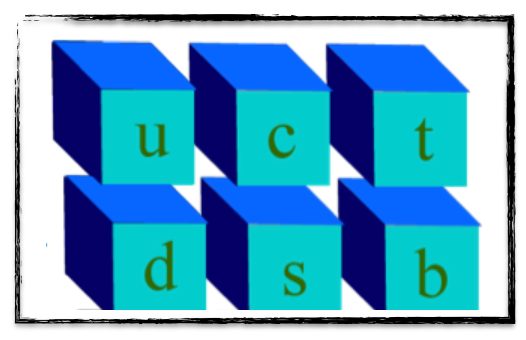
[image credits: homemade (from well spread stuff)]
The Standard Model of particle physics contains six species of quarks, that are known as the up (u), down (d), strange (s), charm (c), bottom (b) and top (t) quarks.
In addition, one can add to that list the corresponding antiquarks: each quark is always mapped with an antiparticle of the same nature.
Let us forget about the top quark. It is special and so heavy that it actually decays too fast for being able to form any composite state. We concentrate instead on the five other guys.
As I detailed it in this older post, quarks and antiquarks can form a composite particles by virtue of the strong interaction.
Such a composite state is the particle that has been discovered.
BARYONS AND THE NEW Ξcc++ PARTICLE

[image credits: everywhere on the web]
Quarks can in particular form systems called baryons.
A baryon is made of three quarks, like for instance two up quarks and one down quarks (uud) or two down quarks and on up quark (ddu). Those are in fact the well known proton and neutrons, as shown on the picture on the right.
Whilst any combination of quarks is in principle possible, as predicted by the theory, many possibilities, in particular those including two c quarks, have never been observed.
The Ξcc++ is one of those missing links, made of two charm quarks and one up quark.
HOW TO OBSERVE THIS NEW Ξcc++ PARTICLE
In order to conclude to the existence of this state, LHCb experimentalists were tracking the signature it would have left once produced. The Ξcc++ is indeed unstable and therefore leaves tracks in the detector when it decays.
We can predict the number of boring collisions yielding to the same signature but when ignoring any possible effect induced by the Ξcc++ particle, and we can also predict what is going on if the Ξcc++ particle exists.
The rest is a matter of comparing data to theory predictions and to tell which hypothesis accommodates data best, and at which confidence level,
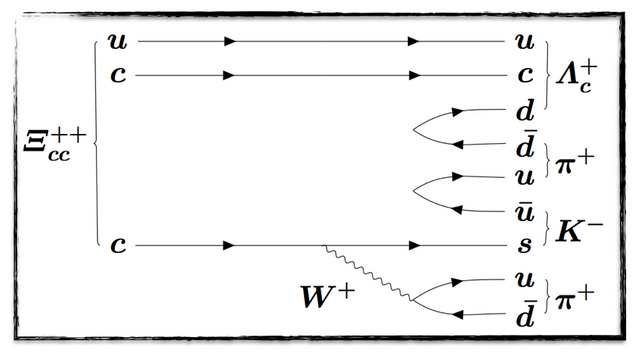
[image credits: the LHCb publication on the discovery]
The signature that has been probed is illustrated on the above picture.
One of the charm quarks (on the bottom of the figure) of the Ξcc is converted into a strange quark (s) and a up-antidown (u dbar) pair.
Moreover, two quark-antiquark pairs (u ubar and d dbar) are created from the vacuum.
The nine produced quarks are then reorganized into one baryon (the Λc+ guy) and three mesons (the two π+ pions and the K+ kaon).
The quark content of this various particles can be guessed from the picture. The key point is that the four particles on the right can be precisely detected and identified.
THE OBSERVATION
From the four particles making the searched signature, one can reconstruct the initial state and study its properties, in order to be sure that we are in the presence of a new particle.
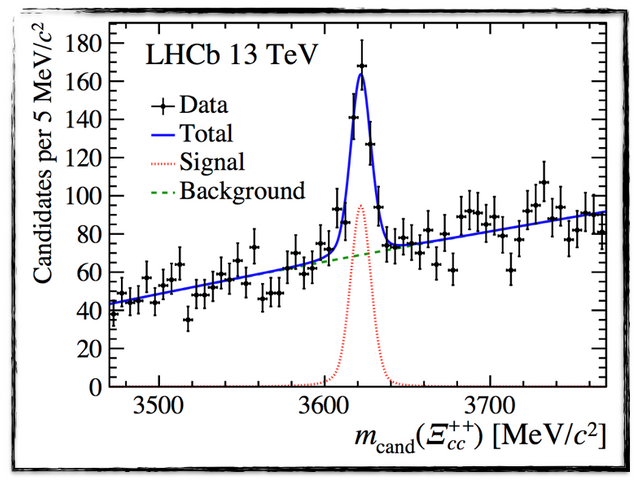
[image credits: the LHCb publication on the discovery]
This is illustrated on the picture shown on the right, where one can see what is expected without the presence of the Ξcc (green dashed line) and with the presence of the Ξcc (solid blue line). The black crosses are the data point.
We have thus a new particle here, and there is no way that the data is compatible with the background-only hypothesis.
In other words, the green line cannot agree with the black crosses and there is in fact less than one chance out of thousands of billions that nature cheats on us.
In addition, this discovery is compatible with signs arising from previous experiments (SELEX and the run 1 of the LHC) but where the confidence level was not high enough to claim anything.
SUMMARY AND REFERENCES
In this post, I summarized one of the announcements made at the EPS-HEP conference earlier this week. The LHCb collaboration of the LHC has announced the discovery of a new particles made of two charm quarks and one up quark, the so-called Ξcc++ particle.
This is very exciting as this consists of the experimental confirmation of a prediction that has finally been observed, and that will allows physicists to further study the theory of the strong interactions.
More information can be found:
Well done post You deserve for getting Upvote from me. I appreciate on it and like it so much . Waiting for your latest post. Keep your good work and steeming on. Let's walk to my blog. I have a latest post. Your upvote is high motivation for me. Almost all Steemians do their best on this site. Keep steeming and earning.
This comment has received a 0.08 % upvote from @booster thanks to: @hamzaoui.
People are really just getting more clever - or is it just because technology is getting better - very impressive - some difficult to understand but good post
We need the technology to be able to test better the theory. The LHC is being considered since the 80ies and now we have it. It hence took time to get the technology necessary to test a theory that is well known today, although at the same time, a lot of mysteries are still around.
In term of being clever... well we learn more and more with time. So yes, we may benefit from time ^^
I agree - some people just amazes me
It's really a great day. It's great that experimentally confirmed scientific prediction.
Scientists do not eat their bread for nothing=)) Joke
Our joint Institute for nuclear research in Dubna has also made a significant contribution to the development of modern physics and chemistry. No wonder the international Union of pure and applied chemistry assigned 105-th element of the Periodic system of elements of D. I. Mendeleev "Dubniy" names.
May me about this post to write?)
Dubniy is not so cool. Dubnyak is better

Ohhhh! Do you drink it? And where was that? I like Armenian brandy

What kind of Armenian brandy are you looking for I know some great ones.
Ohhh. I don't drink enough. Just cognac for the hypotensive sometimes you need, that pressure to raise :=))))
Haha nice way to keep that in control.
Can share :=)))
I'll take it. And bring some of my own. 😁😁🤣
I remember having written something on the names of the chemicals month ago. I cannot get the link now as I type from a phone, sorry.
Is is clear Dubna is one of the leading place concerning the heavy nuclei. One of the latest discovered element has indeed be named in honour of the leading researcher from there.
Please write about this (and let me know, for instance in the chat) :)
@lemouth, I wrote to You in chat — https://discordapp.com/channels/@me/332629833802842113
I was actually referring to the steemit chat rather than discord. I will anyhow come once I will be back from vacation. Typing from a phone at the moment :)
=)))
I'm waiting for the discovery of graviton :)
The graviton itself cannot be discovered at the LHC, but it may be possible to discover some of its excitations as predicted by extra dimensional models.
Why can't the graviton be discovered at the LHC? Do we know its mass? Or it's massless? Or...or.. How.. So many questions..
The graviton is massless, in contrast to the excitation i was mentioning. Which is one of the reason it will hide himself at the lhc. In contrast, its excitations are expected to be very massive so that peaks are expected in the observed distributions of various observables.
ahh How can a graviton be in an excited state?
Let me try to answer concisely (and we can then move forward with details if needed).
In extra-dimensional models, gravity lives in all the dimensions. The graviton is thus attached to a field (like any particle) but this field is an extradimensional field. In terms of four-dimensional objects, this field can be seen as a series of four-dimensional excitations of various masses. The lightest of these excitations is the massless graviton, and the other are the so-called massive KK-gravitons.
Does it help?
Yes a little bit. All this quantum world makes me question everything and wanting to know everything about it!... Ohh What are the for dimensions?
You should keep posting about this subjects for the non scientific populating to learn.
The four dimensions are time and the 3D spatial world.
PS: I didn't stop posting. I just took one week of vacation. I will come back with posting next week :)
That's a great discovery. Bringing new excitement among the scientific community. Hope they are able to work out a more coherent model of the sub atomic world! Resteemed :)
Actually in this case we know already a lot about the model. The unknown is how it exactly works (in details) to make those particles as they are.
In the defined tests, the model fits. Of all the possible tests that exist, we do not know if the model will fit. Also, inside the boundaries of the tests everything may be fine but we do not know how things behaves outside the boundaries.
We still have so much to discover and right now science is at those boundaries in many fields. They have started to collaborate in other fields to have a more complete picture.
Some scientists are moving from quantum physics to quantum biology. Applying the concepts and tools built for quantum physics, they are trying to look inside DNA to see if they can find some answers.
Science is getting more challenging and exciting at the same time!
In this very specific case, it is not really a matter of fitting. We have a model and the observation of this particle was a prediction. The theory is based on some fundamental principle from which we can deduce a lot of things (predictions) from a very small setter of parameters (fitted quantities).
But there are still unknowns, which we are trying to know better.
Now, how to link this to another domain of science is another question, and exciting too :)
What are the physical properties of the particle? Weight, mass, size?
What we know today is that this particle exists, we know its mass, and we have ideas about its width and lifetime.
The mass of the particle is 3.61 GeV/c2 (in standard units for particle masses, 1 GeV/c2 being the mass of the proton). The width is consistent with the experimental resolution we have, and the lifetime as well (we don't have enough information to get precise numbers out of that).
Note that there is no such a thing as a weight as a property of a particle. Moreover, the size is not definite as well (we are living in the quantum world here).
Always interesting the quantum world.
It's a heavy particle then.
This depends how one defines heavy. The mass of the top quark is of 173 GeV / c 2 which is much heavier. And we are expected new elementary particles to be of several of hundreds, possibly thousands, of GeV :)
173 times heavier than the proton? And there are still heavier particles?? I would expect that they should be interacting more with each other or with "normal particles" like neutrons, protons, electrons...
What is a normal particle? The name 'normal' sounds definitely weird to me :)
By the way, a neutron and a proton are not elementary particles, but are made of smaller and lighter entities named quarks. The interactions are in fact not necessarily connected to the mass of the particles (take electromagnetism for instance that is connected to the electric charge of the particles).
Great. Are quarks the smallest possible entities? How about trying to squash them into something smaller? If I where a scientist maybe I would study that at the LHC.
Quarks (and gluons) are actually being smashed into each other at the LHC, and for the moment, there is no apparent sign of any quark substructure. But studies are continuing :)
Although I consider myself intelligent, this looks hard!!
Nice post @lemouth :)
Reading the post I refer to may facilitate the understanding, as said in another comment. In any case i am here for help if needed :)
The subject of the post is very interesting, and you really explain it in the best way. Congrats!
Science advances!
Thanks a lot :)
vote my comment and i vote back
what does this mean in English? lol anyone?
As I said, you nsy need to check my earlier posts on quarks and their interactions. This will help. Otherwise, i can also help for any specific question.